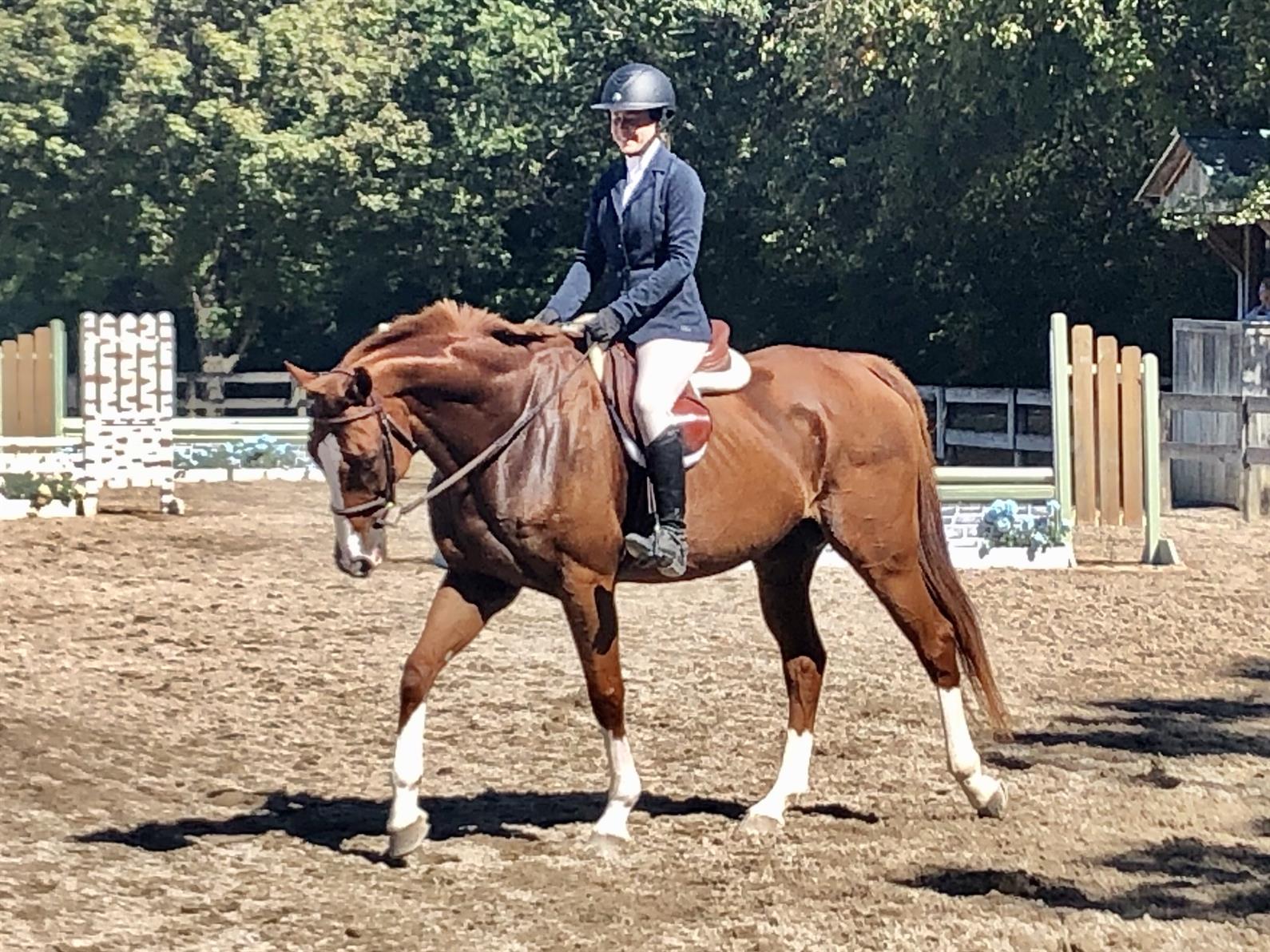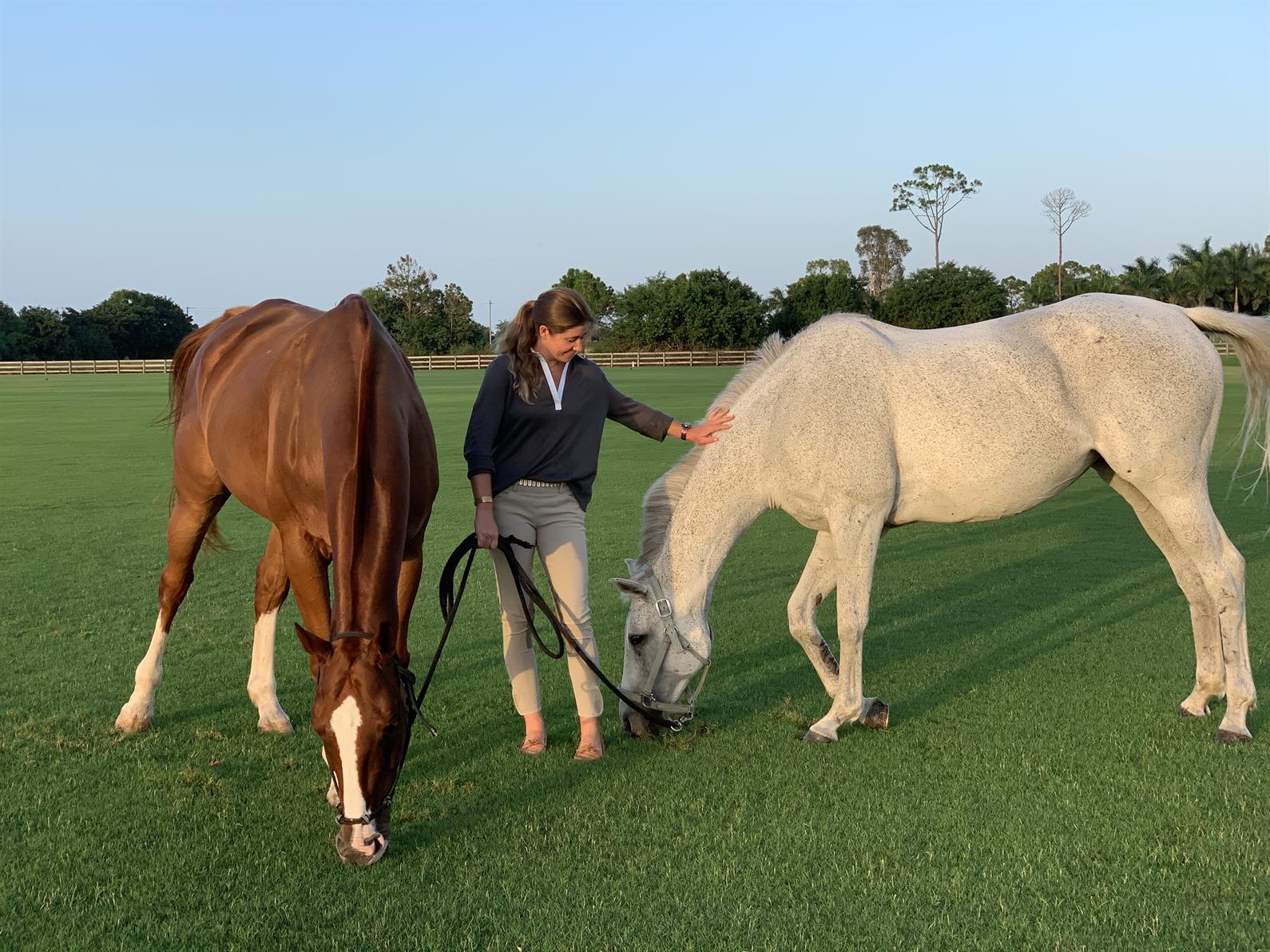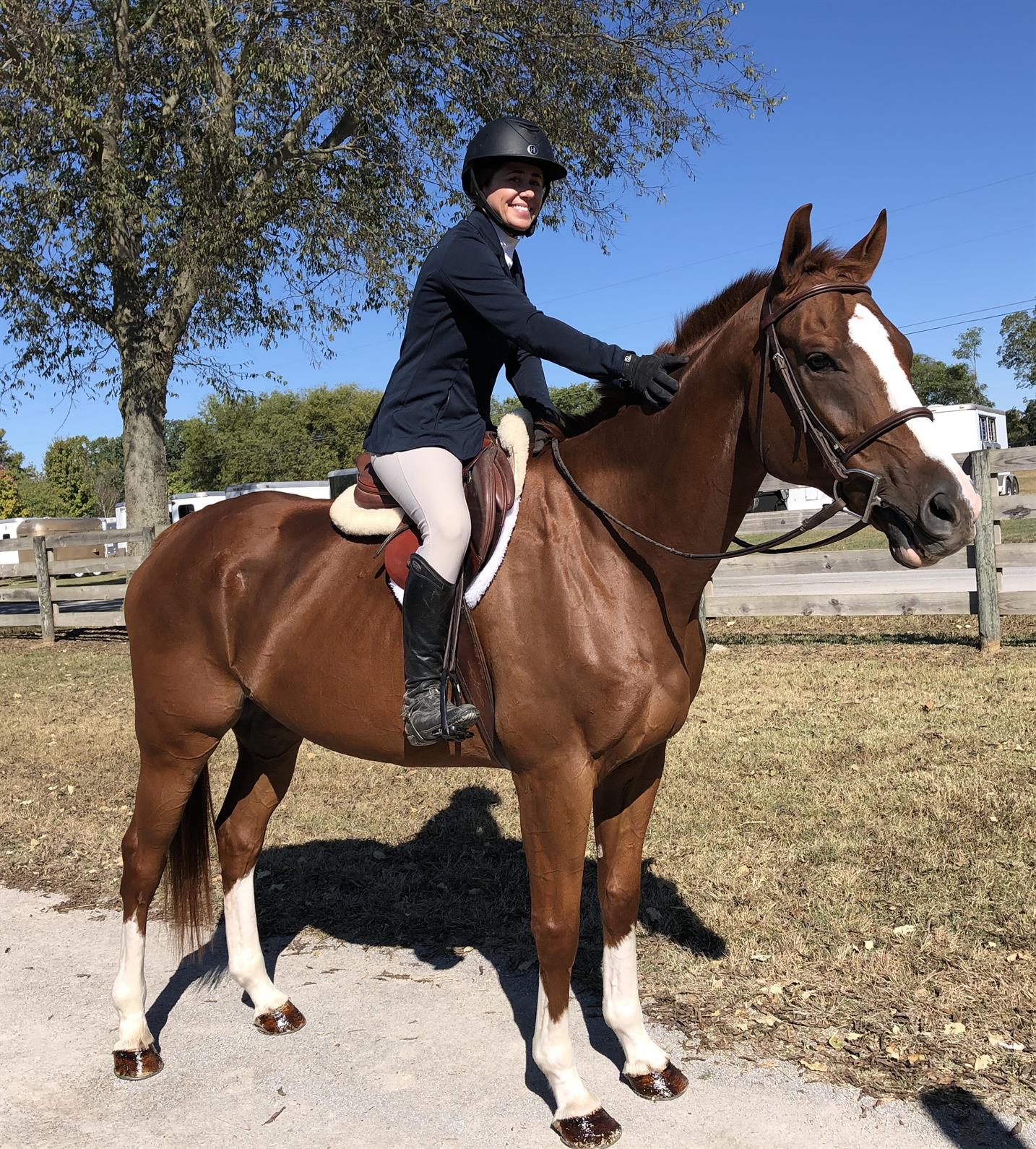
Photo: Tina Halstead
Brittany Halstead had the best of two equestrian worlds—hunter jumpers and polo—when a car crash nearly ended her life in 2014. Her recovery was nothing short of miraculous, and she credits working with two horses, polo ponies Fanta and Dos Equis, for helping her return to the saddle and the show ring. In return, she formed ReplayPolo, which helps transition retired polo ponies into second careers in therapeutic riding, intercollegiate equestrian programs, and more.
“It’s all about mindfulness,” Halstead said of how retraining horses parallels her recovery from traumatic brain injury. “You have to take time, collect your thoughts, and wait it out. It will all come around. You can’t force yourself and you can’t force these horses to do something. You have to step back and ask in a different way. You need patience with yourself and with the horse.”
A Two-Way Education
Halstead, who rode hunter jumpers from the age of 10, got her introduction to polo while working for hunter jumper trainer Elaine Schott, whose husband Trey is an accomplished polo player. “Her husband needed a groom for polo, and so she said, ‘I need you to go groom polo,’” Halstead recalled. “I did, and I just fell in love with the horses. Of course, I got the nickname of The Slowest Groom in North America, because, as a hunter jumper person, I felt the horse had to look perfect before it stepped into the ring. The polo wraps had to be perfect, and the tail had to be braided super-well! But working with the polo ponies was so different. They just stand at the trailer and do not move while you’re moving around them so fast, throwing on tack and throwing off tack. They’re just so patient and have such a great demeanor.”
One polo pony she met on another grooming job exemplified that for Halstead and tugged at her heartstrings.
“It was my first full-time polo grooming job, and this horse, Dos Equis, was only four,” she remembered. “I loved him. He was my favorite. He was so humble and respectful, and he had so much love! He wasn’t used to getting a lot of treats, and he was very respectful about it.”
Working with horses from both the hunter jumper and polo worlds was educational, and Halstead found ways to apply what she learned in one discipline to training in the other.
“The quick, simple transitions that these polo ponies have, and the very acute aids that you give them, that’s something I have applied to the hunter jumpers,” Halstead said. “Riding polo ponies has made me not use artificial aids like the whip and the spur. Some polo players do wear spurs and use draw reins and a whip, but these polo ponies just don’t need it. They appreciate no aids and are very responsive without them—plus, I don’t want to force a horse. It just takes time to get them to be responsive to your natural aids, which is much appreciated.
“I’ve also taken the flat work in the hunter jumpers and applied it to my polo work, like using poles on the ground, doing a counter-canter or a flying change, collecting and extending the trot,” she continued. “I’ve applied all the hunter jumper flat work to polo, but these polo ponies naturally do it all on the field. So now they have to learn using different aids. I think every horse needs a basic level of dressage, and that’s something polo ponies just don’t get; they just kind of get thrown into polo. So the flat work and education of hunters and the dressage are something that I’ve applied to the polo ponies.”
Teaching a polo pony to jump for a new career over fences takes thoughtful training, as Halstead described.

Photo: PoloPeoplePoloPlaces
“You have to place a pole before the jump and actually make the horse rock back on his haunches,” she said. “The pole makes them take a step back and take their time for the fence. These polo ponies can’t just pick out a natural distance, because they’re used to being in a hurry to charge in polo, so they just go for the jump. They’ve got to have gymnastics set up for it, and you’ve got to make sure you don’t get ahead of the horse and that you stay back. They’re very charge-y with their shoulders, because they really use them when they’re blocking a shot, making a shot, or trying to ride another pony off—it’s all in the shoulder. So when you’re trying to get them to jump, they charge at the jump with the shoulder and kind of leave their back end behind, and that’s why you need gymnastics and bounces to teach them to wait and to lift up their front end and push off with their back end.”
In 2014, Halstead moved to Pilar, Argentina, where she looked set to combine her love of both jumping and polo: she’d gotten a job offer from Argentina’s international jumping rider Luis Magnasco and had arranged to live on polo Hall of Famer Guillermo “Memo” Gracida, Jr.’s nearby farm. The future looked promising. And then came the crash.
One morning, as Halstead was traveling in Lobos, Argentina, a car made a U-turn across the highway and hit the farm truck Halstead was riding in. The head-on collision killed the car’s driver, and Halstead, who was not wearing a seat belt, nearly died on the scene. She was in a coma in an Argentine hospital for two weeks before being flown home on a life flight to Nashville, Tenn., to be hospitalized there.
A Boost from Horses on the Road to Recovery
“The whole time I was in the hospital, I was talking about horses and about my job, thinking I’d be back in Argentina in a month,” Halstead said. “I had no idea how injured I was. But a month after I got out of the hospital, my mom took me to ride on a lesson pony that a friend of mine, who is an instructor, put me on. While I was riding, I would say, ‘I feel like I’m in outer space!’ My perception of space was so off. I could trot about halfway down the long side of the ring before I’d have to stop. It would spin me out.
“It was maybe six months before I could canter again,” she continued. “When I was teaching, I’d always tell students, ‘Eyes up! Look where you’re going!’ But now I caught myself staring down at the horse the whole time. I’d tell myself to bring my eyes up, and I couldn’t figure out why I couldn’t. At a walk, I’d also look down at the shoulder. When the left shoulder went forward I’d try to squeeze with my left leg, then do the same with the right shoulder and my right leg. I was trying to ‘walk’ in the same way the horse was going, just to try to get my mind and body in sync with the horse, and I could not do it. I can do it now, but back then it was the hardest thing to do.
“But just doing those little things that we take for granted really helped me get back to where I am today.”
Six months after Halstead left the hospital, a polo player friend contacted her. He had a polo pony he didn’t need anymore, and he wanted Halstead to take the mare, Fanta, a Thoroughbred.
“He couldn’t believe I didn’t have a horse,” she said. “He thought, ‘That’s just what she needs in life right now, is a horse!’ I couldn’t drive for about a year-and-a-half, so my mom used to take me to the barn to ride, and it was like that horse knew that I was off. She would point her ears back at me like she was saying ‘Okay, now it’s time to get into two-point!’ I did get to where I was jumping her over little crossrails. She’d had a bad reputation in polo because she had no mouth and wouldn’t stop, but if I said, ‘Whoa,’ and just slightly pulled back, she’d stop.
“At the time, I did not have the ability to have all my ducks in a row,” Halstead continued. “Getting my tack out, getting the

Photo: Tina Halstead
grooming equipment out, going to get Fanta in the field—doing everything you have to do before you even get on a horse was almost impossible for me. So the fact that I had this horse that was like a golden retriever, like a service animal, allowed me to be able to do it. I could never have done that with a horse that runs around in the field and won’t stand still in the cross-ties; that would have thrown me over the top. And when I needed to stop and just sit there and gain some mindfulness and think about what I would do next, she would do that for me. She’d just wait until I wanted her to move again. That was a big plus.”
Halstead’s biggest challenge in riding was regaining her balance.
“My balance was really thrown off, and that was because my visual processing center was the most damaged,” she explained. Halstead credits working with Fanta and her participation in a vision therapy program in California—which helped her be able to raise her eyes and look ahead while riding—with helping her regain skills in the saddle.
“I had been riding with Olympic riders before the accident, but, after it, just being able to get in two-point and trot over a pole was a huge, amazing success,” she said.
Fanta eventually went on to a new job as a broodmare, but Halstead never forgot how helpful the mare had been on the road to recovery. Inspired, in 2016 she founded ReplayPolo to help retired polo ponies find new jobs. Luis Escobar, the owner of Santa Clara Polo Club in Wellington, Fla., donated space there to get the program started.
A Reunion
Three years after she launched ReplayPolo, Halstead bumped into polo owner and United States Polo Association Hall of Famer Ruben Gracida at Santa Clara Polo Club. He told her he had a horse he wanted to retire to ReplayPolo.
The horse turned out to be Dos Equis. “I couldn’t believe it,” she said. “So I went to ride him, and he was perfect.”

Photo: Brittany Halstead
Dos Equis came to Halstead in June 2019, and he represented the next stage in her recovery. “Now I had a horse in my sole care, and I had to do everything,” she said. “To have that daily routine of feeding and tacking and riding and cleaning was really difficult for me, especially in the heat. It took a couple of months to sort of reprogram my mind, and then I started taking lessons with another show jumper.
“Dos Equis was really coming around—he hadn’t refused a jump or backed up at all—and so I took him to the showgrounds and schooled there in a ticketed warm-up ring. He’d never set foot on a showgrounds before, but he walked right in, jumped over everything, and didn’t knock down a pole.”
For Halstead, Dos Equis provided a helpful mental and physical workout, as well as a confidence boost.
“I was trying to get Dos Equis ready for a show, and that took a lot of work,” Halstead explained. “It required me to use all of training tools, and I hadn’t been able to train a horse since my accident. To be able to see a horse become more educated in another discipline, and for me to accomplish that, was the confidence I really needed.
“It also helped me get my leg strength back. A few weeks ago I jumped a course with him, and for the first time I finally felt like I was completely in sync with him with my whole body. I didn’t miss a distance, and he got all of the strides that he needed for the course.”
That payoff came after several months of intensive training, but Halstead said that Dos Equis was a trier.
“He always tried very, very hard to please me, and everything I asked of him, he made the effort,” she said. “It took him a long time to understand exactly what I was asking, but that was probably my fault, because, come on, it had been five years since I’d really trained a horse to do something! With time and patience, we each figured out what the other was saying.”
Halstead’s patience with both horses and herself has grown, she says, since her accident.
“Before, I was more like, ‘Okay, do this bending line and jump this at three feet and it has to be done now, because then I’ve got to get on this next horse,’’’ she said. “After my injury, any kind of transition I would do, like going from one type of exercise to another, I just couldn’t do it fast. I had to do it slowly, and I had to really think about the exercise and how I would do it. And at first when I’d try it, I’d be off. But after a few minutes of trying it, I’d get it. I really think that asking your horse to do different things—and we’re asking them to do different things all the time—if you take your time, ask the horse in a gradual and patient way, and let the horse think about it, it leads to better success. That’s something I would never have thought about if this hadn’t happened to me.”
Want more articles like this delivered to your inbox every week? Sign up here to receive our free Equestrian Weekly newsletter.
This article is original content produced by US Equestrian and may only be shared via social media. It is not to be repurposed or used on any other website aside from usequestrian.org.


